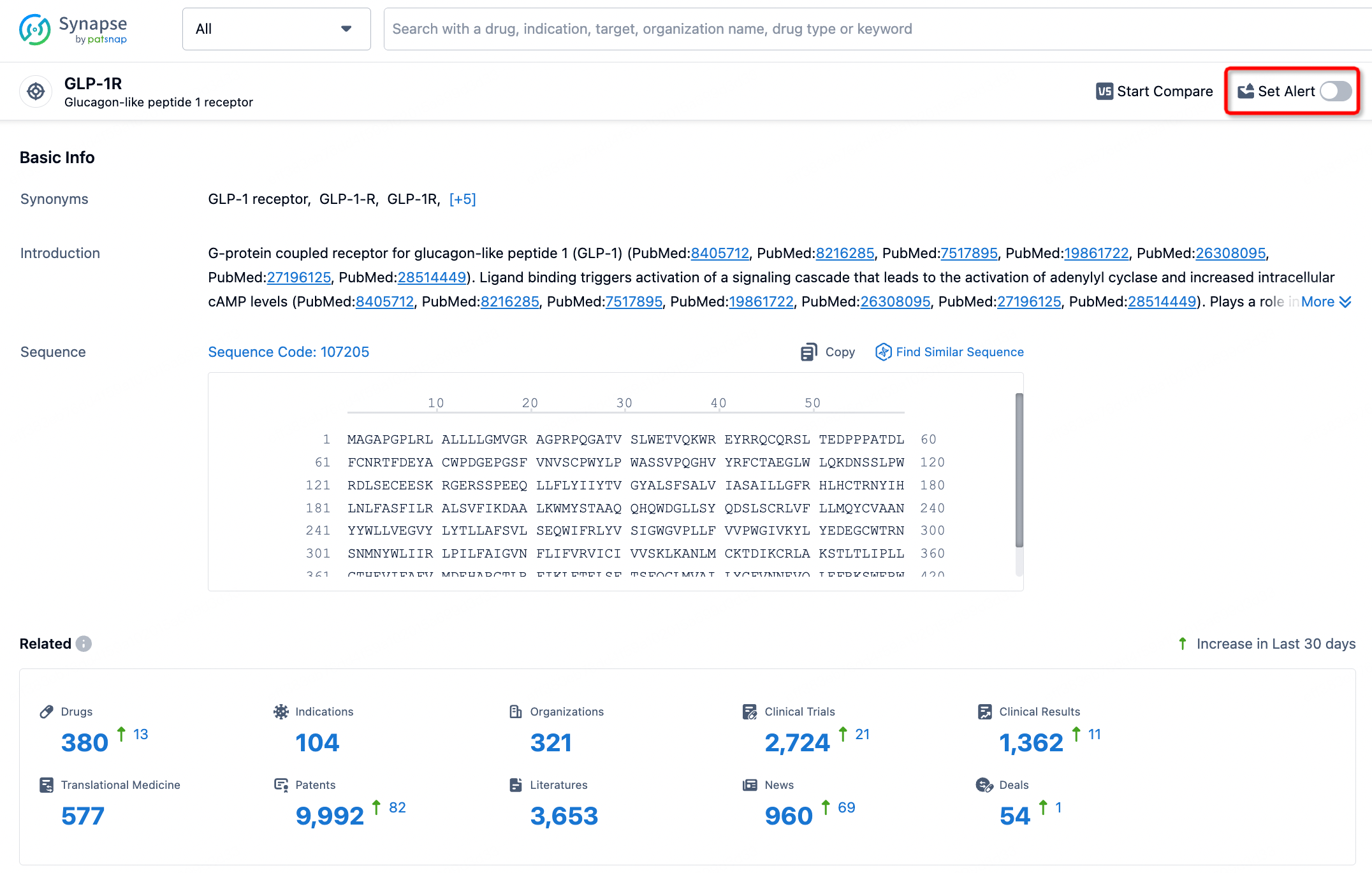Request Demo
What are TNIK inhibitors and how do they work?
21 June 2024
In recent years, the field of targeted cancer therapies has witnessed significant advancements, and one of the promising areas of research involves TNIK inhibitors. TNIK, or TRAF2 and NCK-Interacting Kinase, is an important player in various signaling pathways that are crucial for the proliferation and survival of cancer cells. This blog post will provide an introduction to TNIK inhibitors, explain how they work, and discuss their potential applications.
TNIK inhibitors are a class of therapeutic agents designed to target and inhibit the activity of TNIK. TNIK is a serine/threonine kinase that plays a pivotal role in the Wnt signaling pathway, which is essential for cell division, differentiation, and growth. Abnormal activation of the Wnt pathway is frequently associated with various types of cancer, including colorectal, gastric, and breast cancers. By targeting TNIK, these inhibitors aim to disrupt the aberrant Wnt signaling, thereby impeding cancer cell growth and proliferation.
The mechanism of action of TNIK inhibitors revolves around their ability to inhibit the kinase activity of TNIK. Kinases are enzymes that transfer phosphate groups from high-energy molecules, such as ATP, to specific substrates. This phosphorylation process is a critical regulatory mechanism in many cellular processes, including cell signaling, metabolism, and growth. TNIK inhibitors bind to the active site of the TNIK enzyme, preventing it from phosphorylating its target substrates. This inhibition disrupts downstream signaling pathways that are dependent on TNIK activity, leading to the suppression of cancer cell growth and survival.
More specifically, TNIK inhibitors block the phosphorylation of key components in the Wnt signaling pathway, such as β-catenin. In the absence of TNIK activity, β-catenin is unable to activate transcription of Wnt target genes that promote cell proliferation and survival. Consequently, the inhibition of TNIK results in the downregulation of these oncogenic pathways, making it an attractive strategy for combating cancers driven by Wnt signaling dysregulation.
TNIK inhibitors have shown promise in preclinical studies and early-phase clinical trials for a variety of cancers. One of the primary areas of interest is colorectal cancer, a disease in which Wnt signaling is often aberrantly activated. Research has demonstrated that TNIK inhibitors can reduce tumor growth and enhance the effectiveness of existing treatment modalities, such as chemotherapy and radiation therapy. By sensitizing cancer cells to these treatments, TNIK inhibitors may improve patient outcomes and reduce the likelihood of resistance.
In addition to colorectal cancer, TNIK inhibitors are being explored for their potential in treating other malignancies, including gastric and breast cancers. These cancers also frequently exhibit dysregulated Wnt signaling, making them suitable targets for TNIK inhibition. Furthermore, there is growing interest in investigating the role of TNIK inhibitors in other diseases characterized by aberrant Wnt signaling, such as certain types of leukemia and lymphoma.
Beyond oncology, TNIK inhibitors hold potential in the field of regenerative medicine. The Wnt signaling pathway is not only implicated in cancer but also plays a crucial role in tissue regeneration and stem cell maintenance. By modulating TNIK activity, it may be possible to enhance tissue repair and regeneration in conditions such as wound healing, bone fractures, and neurodegenerative diseases. However, these applications are still in the early stages of research and require further investigation.
In conclusion, TNIK inhibitors represent a promising avenue in the realm of targeted cancer therapy. By specifically inhibiting a key kinase involved in the Wnt signaling pathway, these agents have the potential to disrupt cancer cell growth and improve treatment outcomes. While much of the current research has focused on colorectal, gastric, and breast cancers, the versatility of TNIK inhibitors suggests they may have broader applications in oncology and regenerative medicine. As ongoing studies continue to elucidate the full potential of TNIK inhibitors, they may pave the way for more effective and targeted treatments for a variety of diseases.
TNIK inhibitors are a class of therapeutic agents designed to target and inhibit the activity of TNIK. TNIK is a serine/threonine kinase that plays a pivotal role in the Wnt signaling pathway, which is essential for cell division, differentiation, and growth. Abnormal activation of the Wnt pathway is frequently associated with various types of cancer, including colorectal, gastric, and breast cancers. By targeting TNIK, these inhibitors aim to disrupt the aberrant Wnt signaling, thereby impeding cancer cell growth and proliferation.
The mechanism of action of TNIK inhibitors revolves around their ability to inhibit the kinase activity of TNIK. Kinases are enzymes that transfer phosphate groups from high-energy molecules, such as ATP, to specific substrates. This phosphorylation process is a critical regulatory mechanism in many cellular processes, including cell signaling, metabolism, and growth. TNIK inhibitors bind to the active site of the TNIK enzyme, preventing it from phosphorylating its target substrates. This inhibition disrupts downstream signaling pathways that are dependent on TNIK activity, leading to the suppression of cancer cell growth and survival.
More specifically, TNIK inhibitors block the phosphorylation of key components in the Wnt signaling pathway, such as β-catenin. In the absence of TNIK activity, β-catenin is unable to activate transcription of Wnt target genes that promote cell proliferation and survival. Consequently, the inhibition of TNIK results in the downregulation of these oncogenic pathways, making it an attractive strategy for combating cancers driven by Wnt signaling dysregulation.
TNIK inhibitors have shown promise in preclinical studies and early-phase clinical trials for a variety of cancers. One of the primary areas of interest is colorectal cancer, a disease in which Wnt signaling is often aberrantly activated. Research has demonstrated that TNIK inhibitors can reduce tumor growth and enhance the effectiveness of existing treatment modalities, such as chemotherapy and radiation therapy. By sensitizing cancer cells to these treatments, TNIK inhibitors may improve patient outcomes and reduce the likelihood of resistance.
In addition to colorectal cancer, TNIK inhibitors are being explored for their potential in treating other malignancies, including gastric and breast cancers. These cancers also frequently exhibit dysregulated Wnt signaling, making them suitable targets for TNIK inhibition. Furthermore, there is growing interest in investigating the role of TNIK inhibitors in other diseases characterized by aberrant Wnt signaling, such as certain types of leukemia and lymphoma.
Beyond oncology, TNIK inhibitors hold potential in the field of regenerative medicine. The Wnt signaling pathway is not only implicated in cancer but also plays a crucial role in tissue regeneration and stem cell maintenance. By modulating TNIK activity, it may be possible to enhance tissue repair and regeneration in conditions such as wound healing, bone fractures, and neurodegenerative diseases. However, these applications are still in the early stages of research and require further investigation.
In conclusion, TNIK inhibitors represent a promising avenue in the realm of targeted cancer therapy. By specifically inhibiting a key kinase involved in the Wnt signaling pathway, these agents have the potential to disrupt cancer cell growth and improve treatment outcomes. While much of the current research has focused on colorectal, gastric, and breast cancers, the versatility of TNIK inhibitors suggests they may have broader applications in oncology and regenerative medicine. As ongoing studies continue to elucidate the full potential of TNIK inhibitors, they may pave the way for more effective and targeted treatments for a variety of diseases.
How to obtain the latest development progress of all targets?
In the Synapse database, you can stay updated on the latest research and development advances of all targets. This service is accessible anytime and anywhere, with updates available daily or weekly. Use the "Set Alert" function to stay informed. Click on the image below to embark on a brand new journey of drug discovery!
AI Agents Built for Biopharma Breakthroughs
Accelerate discovery. Empower decisions. Transform outcomes.
Get started for free today!
Accelerate Strategic R&D decision making with Synapse, PatSnap’s AI-powered Connected Innovation Intelligence Platform Built for Life Sciences Professionals.
Start your data trial now!
Synapse data is also accessible to external entities via APIs or data packages. Empower better decisions with the latest in pharmaceutical intelligence.


